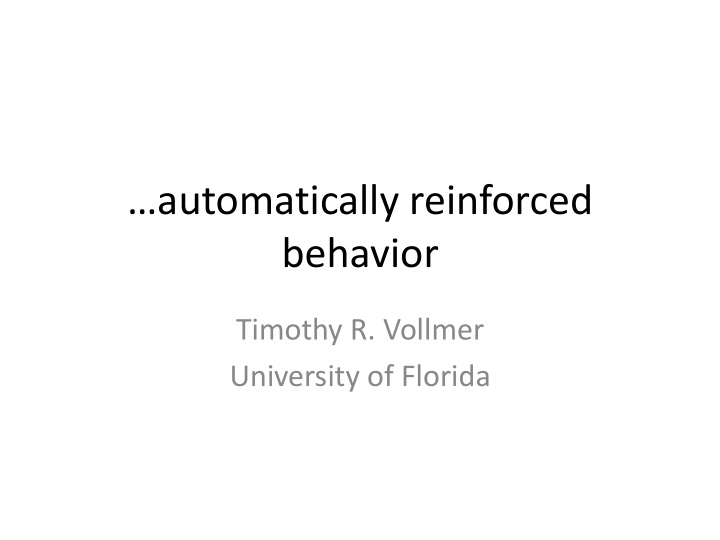



…automatically reinforced behavior Timothy R. Vollmer University of Florida
Overview • A bit about my background and research interests • Overview of the functions of severe problem behavior • Typical treatment logic and why it does not always apply to automatically reinforced behavior • Subtypes of automatic reinforcement • Treatment approaches for automatically reinforced behavior; limitations and silver linings • Assessment approaches for automatically reinforced behavior • Time permitting: The role of skills training • Time permitting: parent and careprovider training.
My background • Ph.D. in psychology under Brian Iwata in 1992. • School Psychology faculty at Louisiana State from 1992- 1996. • Medical School faculty at University of Pennsylvania in 1996-1998. • University of Florida Psychology Professor (Psychiatry affiliate) from 1998-current
Related Research Interests • Assessment and treatment of severe behavior disorders • Differential and noncontingent reinforcement as treatment • Automatically reinforced problem behavior • Parent and careprovider training
Current Project Sites • Behavior analysis research clinic • Florida autism centers • State of Iowa • Gainesville area schools • Rural school districts surrounding Gainesville
Severe Problem Behavior • Self-injurious Behavior (SIB) • Aggression • Property Destruction • Tantrums • Climbing in dangerous ways • Elopement
Operant functions of Severe Problem Behavior • Positive Reinforcement in the form of attention • Positive Reinforcement in the form of tangible items • Negative Reinforcement in the form of escape from instructional activity, self-care activity, aversive social contexts, etc. • Automatic positive or negative reinforcement • “Automatic” means simply that the reinforcement is not socially mediated.
Methods used to identify function • Indirect assessments (questionnaires, checklists) • Descriptive methods • Functional analysis methods (experimental analysis)
Two examples of automatically reinforced SIB (Ringdahl et al., 1997)
Questions?
Treatment logic for socially reinforced behavior • By identifying the reinforcer via FA, the reinforcement of problem behavior can be minimized (ideally extinction). • And, the reinforcer can be used to either strengthen some alternative behavior (differential reinforcement) or abolish the strength of the motivating operations (noncontingent reinforcement)
Prognosis • Treatment of socially reinforced behavior good prognosis • Treatment of automatically reinforced behavior not so good.
Evidence of automatically reinforced behavior as operant behavior • Access to the behavior increases behavior that produces that access. • The behavior goes away if the stimulus products are sufficiently blocked. • Many appropriate forms of behavior are known to be maintained by automatic reinforcement
Alternative (viable) mechanisms • Elicited “biting” when the organism experiences aversive stimulation (e.g., Hutchinson, 1977) • Elicited or schedule-induced aggression (e.g., Azrin) • “Damage” to another organism as reinforcement • These possible mechanisms need up-to-date research with humans
Typical treatment progression • Environmental Enrichment • Differential Reinforcement • Blocking, brief timeout, or mild punishment • More extreme punishment or restraint
Consider the possible functions of response blocking • It can function as positive reinforcement • It can function as extinction • It can function as punishment
Questions?
Idiosyncratic examples: Pica and Vocal Stereotypy
Be wary of RIRD procedure
Considerations in developing Treatment • Stimulus preference • Effects of preferred stimulus on problem behavior • Effects of response blocking (see other slide on this topic) • Skill development • Care provider training
Care-provider Training: behavioral skills training • Discussion • Modeling • Role play with feedback • In situ with immediate feedback • In situ with delayed feedback
Summary • The prognosis for effective treatment is more favorable for socially reinforced behavior than it is for automatically reinforced behavior. • Automatic reinforcement simply means reinforcement in the absence of social mediation. • Typical interventions involve environmental enrichment, differential reinforcement, and possibly mild punishment such as response blocking. • Careproviders should be trained to competency using a behavioral skills training model.
Questions?
Recommend
More recommend